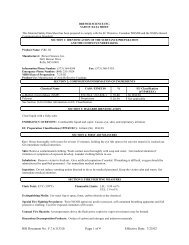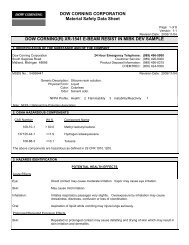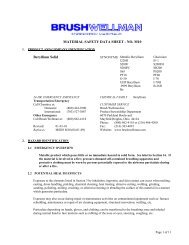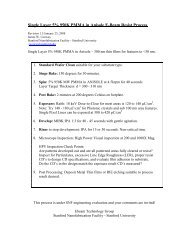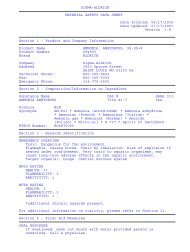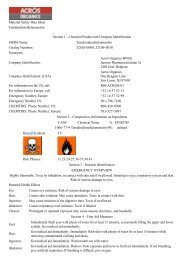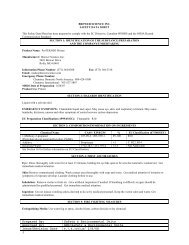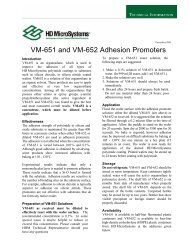Approved By: - Stanford Nanofabrication Facility
Approved By: - Stanford Nanofabrication Facility
Approved By: - Stanford Nanofabrication Facility
You also want an ePaper? Increase the reach of your titles
YUMPU automatically turns print PDFs into web optimized ePapers that Google loves.
<strong>Approved</strong> <strong>By</strong>:<br />
D. Mehls 2/4/97<br />
<strong>Approved</strong> <strong>By</strong>:<br />
W. Hocevar 2/4/97<br />
Prepared <strong>By</strong>:<br />
B. Hocevar<br />
M. Collis<br />
Rev.<br />
N/C<br />
A<br />
B<br />
C<br />
Date<br />
2-4-97<br />
11-15-99<br />
10-22-04<br />
4-26-06<br />
MORGAN ELECTRO CERAMICS<br />
Type: Material<br />
Specification<br />
Title: MSDS for PZT Powder<br />
Initial Release<br />
DCN 9096<br />
DCN 10593<br />
DCN 10926<br />
Revision Record<br />
Change Description<br />
MC<br />
TJ<br />
MP<br />
Document m:<br />
MS-1379<br />
Creation Date:<br />
2-4-97<br />
Changed <strong>By</strong><br />
Page 1 of 7 Computer Generated Document Do Not Change Manually MS1379.C
TITLE:<br />
MSDS for PZT Powder<br />
TYPE<br />
DOC .<br />
NUM.<br />
Specification<br />
MS-1379<br />
MATERIAL SAFETY DATA SHEET<br />
UCT AND COMPANY IDENTIFICATION<br />
Manufacturer’s Name Emergency Telephone Number<br />
Morgan Electro Ceramics<br />
(440) 232-8600<br />
CHEMTREC: 1-800-424-9300<br />
Address Date Prepared<br />
232 Forbes Road<br />
Bedford, Ohio 44146<br />
February 17, 2006<br />
(Replaces October, 2004 version)<br />
Product Name Trade Names and Synonyms<br />
Piezoelectric Ceramic Powder:<br />
Lead Zirconate Titanate (PZT)<br />
Lead Magnesium Niobate – Lead<br />
Titanate (PMN-PT)<br />
Potential Health Effects:<br />
Rev. C<br />
MEC Grades: PZT-402, PZT-404, PZT-4M, PZT4S, PZT-<br />
5A3, PZT-501, PZT-5H2, PZT-5J1, PZT-5K, PZT-5L, PZT-<br />
502, PZT-508, PZT-701, PZT-702, PZT-801, PZT-8D, PZT-<br />
8M, PMN-PT<br />
SECTION 2—HAZARDS IDENTIFICATION<br />
Eyes: Can cause mechanical irritation. Particles imbedded in the eyes can cause<br />
inflammation, degeneration of tissue and discoloration.<br />
Skin: Repeated and prolonged exposure can cause irritation and dermatitis,<br />
mostly through mechanical abrasion. The toxic metal constituents are<br />
present as complex mixtures of oxides and are not generally released from<br />
the products or absorbed through skin.<br />
Ingestion: Ingested lead-containing dust can accumulate in the body and cause longterm<br />
damage to the nervous system, the brain and kidneys. Exposure to<br />
Lead has been linked to reproductive disorders and birth defects.<br />
Inhalation: Chronic (long term) exposure to inhalable Lead-containing dusts may<br />
cause health effects similar to that for ingestion. Exposure to dust can<br />
cause respiratory irritation, especially aggravating to pre-existing<br />
conditions and long-term inhalation of dust can result in lung damage.<br />
Page 2 of 7 Computer Generated Document Do Not Change Manually MS1379.C
TITLE:<br />
MSDS for PZT Powder<br />
TYPE<br />
DOC .<br />
NUM.<br />
Specification<br />
MS-1379<br />
SECTION 3—COMPOSITION INFORMATION<br />
Lead Zirconate Titanate or Lead Magnesium Niobate-Lead Titanate.<br />
Rev. C<br />
These materials are complex oxide ceramics. The ceramics contain no discrete elemental<br />
metal or metal oxide components that may become chemically or biologically available<br />
during normal handling and use. The raw materials for these products include hazardous<br />
components. Lead and its compounds make up 70% by weight of the products, nickel and<br />
its compounds up to 5% by weight, and uranium and antimony and their compounds up to<br />
1% by weight.<br />
No specific hazard information is available on the dust that may be generated from these<br />
products during normal handling and use. Therefore, as a precautionary measure, these<br />
products should be treated as if their hazardous components were chemically or biologically<br />
available during normal handling and use. Lead may be leached from these products in<br />
neutral, acidic and alkaline aqueous solutions.<br />
SECTION 4—FIRST AID PROCEDURES<br />
Eyes: Flush with water. Seek medical attention if irritation continues.<br />
Skin: If irritation develops, wash exposed area with soap and water. Remove<br />
contaminated clothing and launder before re-use.<br />
Ingestion: No adverse effects requiring first aid are anticipated by this route of exposure<br />
in normal handling and use. However, if symptoms develop or persist, seek<br />
medical attention. In case of an acute ingestion, induce vomiting in a<br />
conscious individual and seek medical attention.<br />
Inhalation: In the case of acute exposure, remove individual to fresh air and seek medical<br />
attention if<br />
symptoms develop or persist.<br />
Page 3 of 7 Computer Generated Document Do Not Change Manually MS1379.C
TITLE:<br />
MSDS for PZT Powder<br />
TYPE<br />
DOC .<br />
NUM.<br />
SECTION 5—FIRE FIGHTING MEASURES<br />
Specification<br />
MS-1379<br />
This product is not very combustible, but may burn if exposed to high temperatures.<br />
Flash<br />
Point:<br />
Not applicable. Flammable<br />
Limits:<br />
Not applicable.<br />
Extinguishing Media: Use CO2, sand, dry chemical or water to extinguish.<br />
Rev. C<br />
Special Fire Fighting Procedures: Use protective clothing and self-contained breathing<br />
apparatus appropriate for the surrounding fire.<br />
Unusual Fire and Explosion Hazards: Metal Oxide fumes, vapor and/or dust may occur<br />
and are considered toxic and respiratory irritants.<br />
SECTION 6—ACCIDENTAL RELEASE MEASURES<br />
Clean area of spill, returning all material possible to container. Wear gloves, goggles and<br />
an appropriate NIOSH-approved respirator, if airborne concentrations exceed established<br />
exposure limits. Avoid creating, breathing and ingesting airborne dust. Use a vacuum with<br />
a high efficiency filters (HEPA). Do not broom, sweep or use compressed air for cleaning.<br />
SECTION 7—HANDLING AND STORAGE<br />
Store in cool, dry, well-ventilated area away from strong acids and bases. Practice good<br />
housekeeping to avoid the accumulation of dust in the workplace and with the<br />
requirements set forth in the OSHA Lead Standard 29 CFR 1910.1025. Avoid creating and<br />
breathing airborne dust. Use a vacuum with a high efficiency filters (HEPA) if significant<br />
amounts of dust are created. Do not broom, sweep or use compressed air to blow off dust.<br />
Wash hands thoroughly after handling and do not eat or drink in areas where handled.<br />
SECTION 8—EXPOSURE CONTROLS/PERSONAL PROTECTION<br />
Before using these products, be familiar with the OSHA Lead Standard, 29 CFR 1910.1025.<br />
Controlling exposures to dust to meet the lead permissible exposure limit (PEL) will ensure<br />
that the PELs for nickel, uranium and antimony will not be exceeded.<br />
MATERIAL CAS NO. OSHA PEL ACGIH TLV<br />
Lead 7439-92-1 0.05 mg/m 3 0.05 mg/m 3<br />
Zirconium 7440-67-7 5 mg/m 3 5 mg/m 3 TWA, 10 mg/m 3 STEL<br />
Titanium 7440-32-6 None Established None Established<br />
Niobium 7440-03-1 None Established None Established<br />
Strontium 7440-24-6 None Established None Established<br />
Nickel 7440-02-0 1 mg/m 3 1.5 mg/m 3<br />
Barium 7440-39-3 None Established None Established<br />
Page 4 of 7 Computer Generated Document Do Not Change Manually MS1379.C
TITLE:<br />
MSDS for PZT Powder<br />
TYPE<br />
DOC .<br />
NUM.<br />
Specification<br />
MS-1379<br />
Rev. C<br />
MATERIAL CAS NO. OSHA PEL ACGIH TLV<br />
Lanthanum 7439-91-0 None Established None Established<br />
Iron 7439-89-6 0.5 mg/m 3 0.5 mg/m 3<br />
Uranium 7440-61-1 0.25 mg/m 3 0.2 mg/m 3 TWA, 0.6 mg/m 3 STEL<br />
Antimony 7440-36-0 0.5 mg/m 3 0.5 mg/m 3<br />
Manganese 7439-96-5 1 mg/m 3 0.2 mg/m 3<br />
Yttrium 7440-65-5 1 mg/m 3 1 mg/m 3<br />
Tin 7440-31-5 2 mg/m 3 2 mg/m 3<br />
Ventilation: Provide sufficient general and local exhaust ventilation to maintain<br />
airborne concentrations below established exposure limits.<br />
Respiratory<br />
Protection:<br />
Protective<br />
Clothing:<br />
Use an appropriate NIOSH-approved respirator if airborne<br />
concentrations exceed established exposure limits. Utilization of<br />
respiratory equipment should be in accordance with 29 CFR<br />
1910.1025 and 29 CFR 1910.134<br />
Avoid direct skin contact, wear normal work clothing during product<br />
use and handling. Protective clothing is required if lead exposure<br />
exceeds PEL (see above). Work clothing should be left at work site<br />
and be properly laundered or disposed after use, with the wash<br />
water disposed of in accordance with local, state and federal<br />
regulations. Personal clothing, including shoes should be protected<br />
from contamination.<br />
Eye Protection: Wear chemical/safety glasses with side shields.<br />
SECTION 9—PHYSICAL AND CHEMICAL PROPERTIES<br />
Appearance: Yellow or tan powder Odor: No odor<br />
Melting Point: 1,647 °F<br />
(Approximately)<br />
Vapor Pressure<br />
(mmHg):<br />
10 @ 1,985 °F Percent<br />
Volatile:<br />
Vapor Density: Not applicable Evaporation<br />
Rate:<br />
Solubility in Water: Not applicable Specific<br />
Gravity:<br />
Boiling Point: 2,691 °F<br />
(Approximately)<br />
Not applicable<br />
Not applicable<br />
Page 5 of 7 Computer Generated Document Do Not Change Manually MS1379.C<br />
7.6
TITLE:<br />
MSDS for PZT Powder<br />
TYPE<br />
DOC .<br />
NUM.<br />
Specification<br />
MS-1379<br />
SECTION 10—STABILITY AND REACTIVITY<br />
Stability: Stable to 500 °C. Do not heat in the presence of strong oxidizers.<br />
Hazardous<br />
Decomposition:<br />
Hazardous<br />
Polymerization:<br />
Rev. C<br />
High temperatures or fire may produce metal oxide fumes, vapor and/or<br />
dust.<br />
Not applicable.<br />
SECTION 11—TOXICOLOGICAL INFORMATION<br />
Carcinogenicity: The International Agency for Research on Cancer (IARC) classifies Lead Compounds (not<br />
metallic lead) as a Category 2A (probably carcinogenic to humans). The National Toxicology Program (NTP)<br />
classifies Lead/Lead Compounds as reasonably anticipated to be a human carcinogen based on limited human<br />
evidence and laboratory testing of animals.<br />
SECTION 12—ECOLOGICAL INFORMATION<br />
Lead has a high acute and chronic toxicity to aquatic life. Lead causes nerve and behavioral effects in animal life<br />
and can bio-accumulate.<br />
SECTION 13—DISPOSAL CONSIDERATIONS<br />
Dispose in accordance with federal, state, and local regulations.<br />
SECTION 14—TRANSPORT INFORMATION<br />
This product is regulated as a hazardous material/dangerous good for transportation purposes by US DOT and<br />
ICAO/IATA. This product is transported as:<br />
Lead compounds, soluble, n.o.s., (Piezoelectric Ceramic Powder), 6.1, UN2291, PG III<br />
Page 6 of 7 Computer Generated Document Do Not Change Manually MS1379.C
TITLE:<br />
MSDS for PZT Powder<br />
TYPE<br />
DOC .<br />
NUM.<br />
Specification<br />
MS-1379<br />
SECTION 15—REGULATORY INFORMATION<br />
CERCLA: Lead/Lead Compounds and nickel are CERCLA Hazardous<br />
Substances, if in a dust form.<br />
Toxic Substances<br />
Control Act (TSCA):<br />
SARA Title III,<br />
Section 313:<br />
All ingredients are listed on the TSCA inventory.<br />
Rev. C<br />
Lead/lead compounds, nickel and antimony are subject to the<br />
reporting requirements of Section 313 of the Emergency Planning<br />
and Community Right-to-Know Act.<br />
OSHA: The control of Lead in general industry is addressed in 29 CFR 1919.1025.<br />
State Regulatory<br />
Information:<br />
No additional information.<br />
SECTION 16—SPECIAL INFORMATION<br />
Reasonable care has been taken in the preparation of the information contained in this<br />
Material Safety Data Sheet and the information provided is given in good faith. However,<br />
Morgan Electro Ceramics assumes no responsibility as the accuracy of the information<br />
drawn from raw material supplier Material Safety Data Sheets and other sources. No<br />
warranty, expressed or implied, is made. The information contained in this Material Safety<br />
Data Sheet relates to the piezoelectric ceramic powder manufactured and sold by Morgan<br />
Electro Ceramics and to the dust that may be generated in shipping, handling and use.<br />
Distribution Number of Copies<br />
Facilities Manager 1<br />
Purchasing Manager 1<br />
Company Website 1<br />
Page 7 of 7 Computer Generated Document Do Not Change Manually MS1379.C



